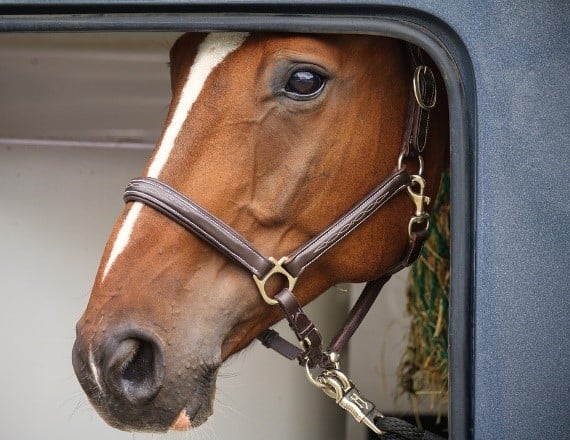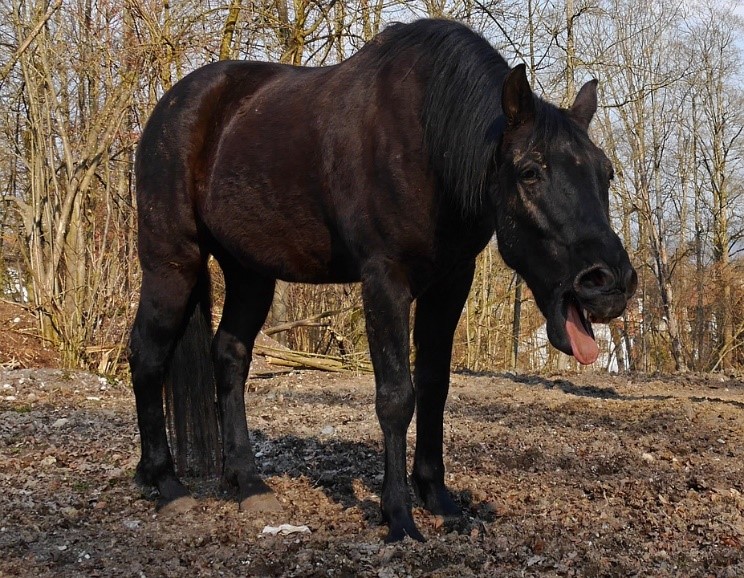What is Shipping Fever in Horses?
 He was a beautiful 9-year-old thoroughbred gelding, and my teenage self was thrilled when my trainer recommended we put down a deposit. There was just one problem… shipping fever.
He was a beautiful 9-year-old thoroughbred gelding, and my teenage self was thrilled when my trainer recommended we put down a deposit. There was just one problem… shipping fever.
Shipping Fever in Horses (Pleuropneumonia): A Serious Respiratory Condition
Shipping fever, or pleuropneumonia, is a serious pulmonary disease that primarily affects horses transported over long distances. My horse fell ill after being transported to and from an auction house, a common scenario for many equestrians who regularly participate in competitions.
This respiratory infection is characterized by the accumulation of fluid in the lungs and pleural cavity (space between the lungs and the chest wall), with symptoms typically emerging about one week post-travel. It begins as a viral infection impairing lung function, which can then lead to a secondary bacterial infection.
The gravity of this condition cannot be overstated: if untreated, shipping fever can necessitate hospitalization or even result in death. This article aims to guide on how to transport horses safely and prevent shipping fever, highlighting symptoms to watch for, and discussing potential treatments.
You may also be interested in reading: Things to Know When Transporting Horses Across State Lines
How is Shipping Fever Spread?
Research shows shipping fever results from a combination of a weakened immune system and environmental factors:
- Weakened Immune System: Often seen in horses transported over long distances, a 2015 study from Poland highlighted how travel stress could trigger cortisol release, weakening the immune system.
- Dust in Airways: Long-distance travel typically prevents horses from clearing dust and debris from their airways. Horses trailered with their heads up—either in cross-ties or with a feed manager in front—cannot lower their heads to expel debris, increasing the risk of inflammation and bacterial growth in the trachea and lungs.
6 Ways to Prevent Shipping Fever While Transporting a Horse

- Avoid Shipping Sick Horses: Shipping a horse with a pre-existing illness can exacerbate their condition. A weakened immune system makes them more susceptible to shipping fever. Consult your veterinarian to determine travel fitness.
- Enhance Trailer Ventilation: Ensure your trailer is well-ventilated. Install large windows, overhead vents, tubular head dividers, and even fans to maintain air quality and circulation.
- Soak Your Hay: Reduce dust intake by soaking hay prior to feeding during travel. Alternatively, refrain from feeding hay during shorter trips.
- Allow Head Movement: Fixed feed mangers and cross-ties restrict natural head movement. Allowing horses to lower their heads during stops aids in clearing accumulated debris.
- Regular Hydration: Ensure water is available throughout the journey, offering it at least every 4-6 hours.
- Consult on Preventative Medication: Some products may help prevent pneumonia and boost immunity, though efficacy varies. Discuss with your vet if such treatments are advisable for your horse.
What are the Symptoms and Treatment of Shipping Fever?

The best thing you can do is catch the illness early so you can start treatment. Look for some of the following symptoms to indicate your horse might have shipping fever:
- Coughing or nasal discharge
- Changes in attitude – lethargy, depression, anxiety
- Low or no appetite for feed
- Elevated body temperature / fever
- Shallow breathing
- Stiff movement
- Reluctance to lie down or move
Call your vet right away to confirm if he has shipping fever. Your vet will likely take some blood for lab tests or recommend ultrasonography to evaluate your horse’s lungs. This will help determine if there is a fluid buildup in the lungs and pleural cavity.
If the fluid is just in the lungs, it is considered pneumonia. Fluid in the pleural cavity is called pleuritis. If there is a large amount of fluid, your vet might withdraw some of this fluid to help determine the best course of treatment.
Treatment for shipping fever may include:
- Antibiotics for several weeks to clear infection,
- Anti-inflammatory drugs to reduce swelling from fluid buildup,
- Chest drain into the pleural cavity,
- Pleural lavage to flush the cavity,
- Supportive care like IV fluids, daily ultrasounds, etc.
If treated early, this disease can be cured without too much disruption. However, the prognosis depends on the severity of the infection and your horse’s existing health. Sometimes months of aggressive treatment is needed. And, unfortunately, sometimes shipping fever is fatal.
What Horse Trailer is Best to Prevent Shipping Fever?

- Tubular Head Dividers: These head dividers serve two real purposes. First, they let your horse see their surroundings so they feel less claustrophobic and nervous about loading. Second, they promote good airflow which helps keep dust and debris from your horse’s lungs.
- Room to Lower Their Head: Look for a trailer that does not have cross-ties or a feed manger. A slant load trailer would be a good option because the horse has room to lower their head enough to snort out debris during travel.
- Overhead Vents / Large Windows: This access to outside air will help keep the levels of dust under control. Dust in your horse’s airway is one of the main factors that leads to shipping fever.
- Water Supply: Look for a trailer that has an onboard water storage system. Better yet, some trailers have individual water troughs available for your horse to drink during travel.
If you’re interested in designing a custom horse trailer with all of these features, check out this horse Trailer Finder tool. It will help you determine what kind of trailer would work best. Then, you can pick and choose features or ask us for help.
Frequently Asked Questions
How long does it take for a horse to get over shipping fever?
About 4 out of 5 horses who get shipping fever will recover within a few weeks. Then, 1 out of 15-20 horses will get true pneumonia and require more aggressive care. The normal course of treatment requires several weeks of antibiotics and rest. Do not rush back into training or else your horse may relapse.
What are the symptoms of shipping fever?
Shipping fever in horses can be recognized by the following symptoms. Call your vet if you suspect your horse might be sick.
- Coughing or nasal discharge
- Changes in attitude – lethargy, depression, anxiety
- Low or no appetite for feed
- Elevated body temperature / fever
- Shallow breathing
- Stiff movement
- Reluctance to lie down or move
What causes shipping fever?
Shipping fever in horses is caused by two main factors: 1) a weakened immune system due to long distance transport. 2) A horse being unable to clear dust and debris from his airways during transport. It is an infection of the lungs and pleural cavity which can be severe or even fatal. Take basic steps to keep your horse healthy during transport by watering down his hay, allowing him space to lower his head to snort, proper trailer ventilation, keeping dust down, providing enough water, not cross-tying in the trailer, and never shipping a sick horse.
How do you prevent shipping fever?
Prevent shipping fever in horses by taking basic steps to keep him healthy during transport. Here are five things you can do:
- Do not ship sick horses with an already weakened immune system.
- Decrease dust in the trailer and make sure there is enough air circulation (even in the winter.)
- Soak your hay to decrease the dust.
- Let him lower his head to snort out debris and avoid cross ties that keep his head up high.
- Provide enough water at least every 4-6 hours at rest stops.
- Ask your vet about preventative medication and immune boosters.

